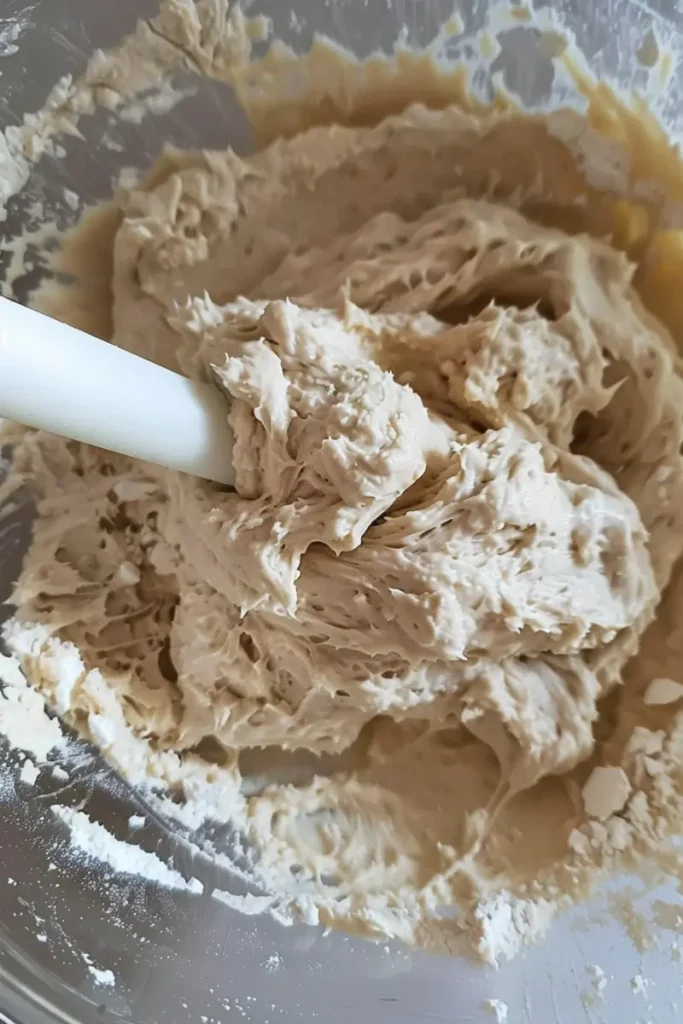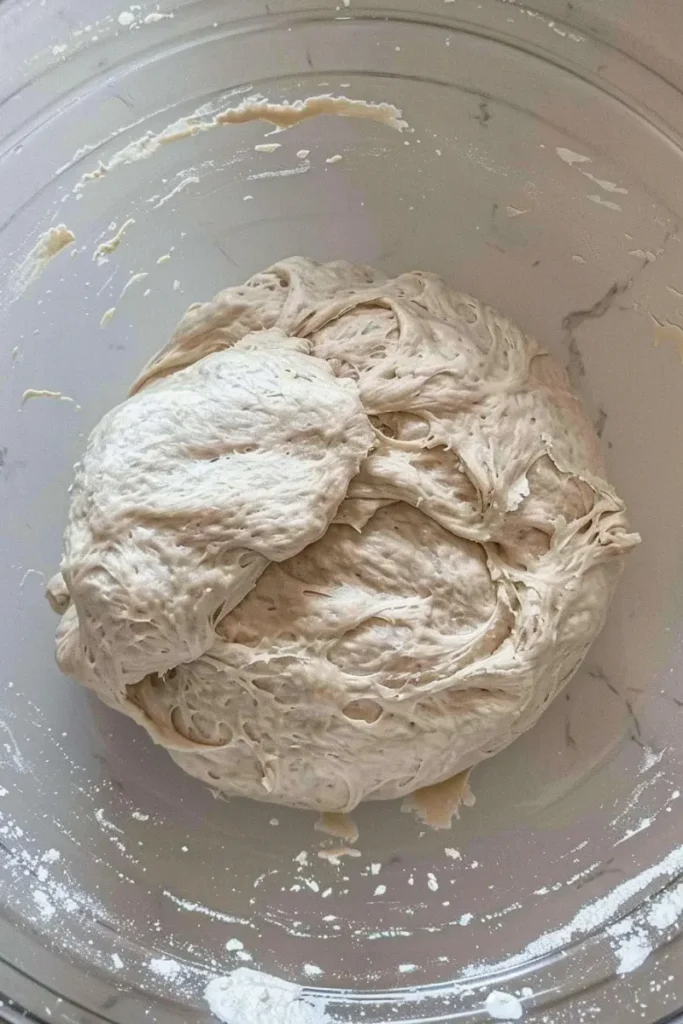Croissant sourdough bread is the luxurious union of two bakery icons crispy, buttery croissants and the tangy, fermented depth of sourdough. This fusion results in a rich, flakey loaf that’s both indulgent and nourishing. With its complex flavor, layered texture, and artisanal appeal, this bread has taken both the home-baking and health-conscious communities by storm.
In this detailed guide, we’ll explore everything you need to know about croissant sourdough bread. From how it’s made, what sets it apart from traditional croissants or sourdough loaves, and why it’s becoming a staple among fitness enthusiasts, to troubleshooting tips and flavor variations—you’ll find it all here. We’ll also unpack its health benefits, answer burning questions like “Is sourdough healthier?” and “Why do bodybuilders eat it?”, and show you how to make your own at home with ease.
Table of Contents
What Is Croissant Sourdough Bread?
What Makes Croissant Sourdough Bread Unique
Croissant sourdough bread is a unique blend of two beloved baked goods—flaky croissants and tangy sourdough. It combines the buttery layers of a croissant with the chewy, fermented depth of sourdough bread. The dough is naturally leavened with a sourdough starter and then laminated with cold butter to create delicate, golden layers.
Unlike traditional croissants that are shaped individually, this hybrid is often baked as a loaf, giving you the richness of pastry with the sliceability of bread. It’s perfect for toasting, sandwiches, or simply enjoying warm with a pat of butter.
The Origins and Rising Popularity of Sourdough-Croissant Fusion
This bread style has grown in popularity as bakers experiment with artisan techniques. Combining sourdough fermentation with laminated dough offers the best of both worlds—flavor and texture. The result is a visually appealing, wholesome loaf that fits both indulgent and health-conscious lifestyles.
Croissant sourdough bread isn’t just a trend—it’s a reflection of modern baking’s creative spirit. From home kitchens to boutique bakeries, this fusion loaf is redefining what bread can be.
Don’t miss our guide on How to Make Sourdough Bread a foundational article for perfecting sourdough texture and rise.

How to Make Croissant Sourdough Bread at Home
Step-by-Step Recipe Breakdown (Starter, Lamination, Bake)
Making croissant sourdough bread requires patience, technique, and the right ingredients—but the payoff is worth it. Here’s a simplified step-by-step guide to get started:
- Prepare the Dough Base
Combine active sourdough starter, bread flour, water, and a pinch of sugar. Let it autolyze for about an hour. Then add salt and mix until smooth. Cover and let rest for bulk fermentation (4–6 hours).

2. Cold Fermentation
After bulk rise, chill the dough in the fridge overnight. This step is essential for structure and easier handling during lamination.

3. Lamination with Butter
Roll out the dough, then layer it with cold, grated or slab butter. Fold it like a letter, then chill. Repeat the folding and chilling process two more times for ideal flakiness.


4. Final Proof and Bake
Shape into a loaf or braid. Let it proof until puffy (3–5 hours), then bake at 400°F (200°C) until golden and crisp, usually 35–40 minutes.
Tips for Perfect Flaky Layers and Fermentation Timing
- Use cold butter only for lamination room temperature butter will melt and ruin the layers.
- Don’t skip resting periods. Chill the dough between folds to avoid tearing and to keep layers defined.
- Pay attention to dough elasticity. If the dough resists rolling, give it more time to relax in the fridge.
- Watch the proof. Over-proofing can flatten the loaf; under-proofing leads to dense texture. Aim for a jiggly, airy feel before baking.
Ingredients and Tools for Making Croissant Sourdough Bread
Best Ingredients for Croissant Sourdough Bread Success
Creating the perfect croissant sourdough bread starts with quality ingredients. The most critical component is your sourdough starter it should be bubbly, active, and pass the float test. A 100% hydration starter (equal parts water and flour) works best for structure and fermentation.
When it comes to flour, always go with high-protein bread flour. Its strong gluten network supports lamination, giving your croissant sourdough bread its flaky, layered texture. Some bakers also mix in a small percentage of whole wheat flour for added flavor depth.
Essential ingredients include:
- European-style unsalted butter, cold and high in fat content
- Fine sea salt for flavor and structure
- Optional: Honey or sugar for sweetness, and milk powder to enhance softness
These ingredients, combined with proper fermentation, create the signature tang and flake in every slice of croissant sourdough bread.
Must-Have Tools for Laminated Sourdough Bread
To achieve beautifully layered croissant sourdough bread, the right tools matter. Here’s what every home baker should have:
| Tool | Function |
|---|---|
| Rolling Pin | Spreads dough evenly for lamination |
| Bench Scraper | Moves and folds cold dough without sticking |
| Kitchen Scale | Ensures accurate, consistent measurements |
| Parchment Paper | Prevents sticking during folding and rolling |
| Dough Lame | Helps with clean, deep scoring pre-bake |
| Proofing Basket | Maintains loaf shape during final fermentation |
| Baking Steel/Stone | Boosts oven spring and crisp crust development |
Having temperature control is crucial. Keep all ingredients and tools cold to prevent butter from melting during lamination. That’s the key to achieving the defined layers that make croissant sourdough bread irresistible.
Croissant sourdough bread rewards precision. With the right combination of ingredients and tools, your homemade loaf will rival anything from a professional bakery.
Learn more about Sourdough Bread Bowl for insights into structure, scoring, and baking crusty artisan loaves
Health Benefits of Croissant Sourdough Bread
Are Sourdough Croissants Healthy?
While croissants are usually considered indulgent, croissant sourdough bread offers a more balanced and health-friendly option. Thanks to its natural fermentation process, it brings digestive and nutritional benefits that standard pastries simply can’t match.
Sourdough starters are rich in wild yeast and beneficial bacteria. During fermentation, these microorganisms break down gluten and phytic acid, making the nutrients in the flour more bioavailable. That means your body can absorb more iron, magnesium, and zinc from a slice of croissant sourdough bread compared to conventional white bread or puff pastry.
And while croissants are typically high in fast-burning carbs, this hybrid loaf has a lower glycemic index due to its slow fermentation. The presence of healthy fats from real butter also helps moderate blood sugar spikes.
Why Sourdough Is Easier to Digest and Less Glycemic
Fermentation doesn’t just enhance flavor it transforms the bread itself. The long proofing time in croissant sourdough bread pre-digests the starches, making them easier on the digestive system. Many people who struggle with regular bread often find sourdough far more tolerable.
Sourdough’s acidity slows down the breakdown of carbs, providing longer-lasting energy. It also supports a healthy gut microbiome by feeding beneficial gut bacteria.
So while this bread still carries a buttery profile, it’s much more than a treat it’s a smart choice for those seeking flavor with function. In moderation, croissant sourdough bread can absolutely be part of a nutritious lifestyle.
Croissant vs. Sourdough Bread – Key Differences
Comparing Texture, Taste, and Technique
Croissant sourdough bread is a hybrid, but it helps to understand how traditional croissants and sourdough bread differ before appreciating what makes the fusion so special.
Texture:
- A croissant is airy, soft, and ultra-flaky thanks to repeated folds of dough and butter (lamination).
- Sourdough bread, by contrast, is chewy with a crisp crust and open crumb due to its long fermentation process.
- Croissant sourdough bread lands right in the middle—crispy crust, tender interior, and visible flake from lamination.
Taste:
- Croissants offer a rich, buttery flavor without much acidity.
- Sourdough bread is known for its mild tang and earthy depth.
- The fusion bread blends buttery notes with the signature sourdough tang, creating a complex bite that’s slightly sweet, slightly sour, and deeply satisfying.
Technique:
- Croissants use commercial yeast for a quick rise and rely heavily on technique for layers.
- Sourdough bread uses a natural starter and requires long, controlled fermentation.
- Croissant sourdough bread combines both: a sourdough starter with lamination, demanding skill, patience, and precise timing.
Which One Is Better for Your Health Goals?
If your goal is simple carbs and indulgence, a standard croissant wins. But if you’re focused on better digestion, longer satiety, and lower glycemic impact, sourdough takes the lead.
Croissant sourdough bread offers a smart middle ground. You get the flaky texture and rich taste of a croissant, paired with the fermented benefits of sourdough. It’s a healthier option without sacrificing the experience of a great bake.
Check out Sourdough Cinnamon Rolls Recipe to explore enriched sourdough doughs that use layering like croissants.
Why Athletes and Bodybuilders Choose Sourdough
Nutritional Benefits for Muscle Recovery
Many athletes and bodybuilders are turning to croissant sourdough bread as part of their nutrition plan. Thanks to natural fermentation, this bread offers slow-digesting carbs, essential for fueling workouts and aiding muscle recovery.
The sourdough process reduces anti-nutrients like phytic acid, allowing your body to better absorb minerals such as zinc and magnesium—vital for muscle repair. Combined with a protein source like eggs or lean meat, croissant sourdough bread becomes a well-balanced meal that promotes recovery and energy stability.
Low-Sugar, High-Satiety Qualities of Sourdough
Unlike regular croissants or white bread, croissant sourdough bread has a lower glycemic index and higher satiety value. This helps bodybuilders avoid energy crashes and manage appetite during training or cutting phases.
The complex carbohydrates in sourdough digest more slowly, offering sustained energy without spiking blood sugar. For athletes watching their carb quality, this hybrid bread provides the indulgence of a croissant with the performance benefits of sourdough.
It’s a functional food that fits into fitness-focused diets—rich in flavor, easy on digestion, and supportive of clean eating goals.
Creative Variations and Flavor Additions
Sweet and Savory Croissant Sourdough Loaf Ideas
One of the best things about croissant sourdough bread is its versatility. Whether you’re craving something sweet or savory, this hybrid loaf adapts beautifully to both. For sweet variations, try folding in layers of:
- Cinnamon sugar for a sticky bun twist
- Dark chocolate chunks for a pain-au-chocolat vibe
- Dried fruits like figs or cranberries for a tangy, chewy texture
For savory options, consider adding:
- Shredded cheese and herbs like rosemary or thyme
- Sun-dried tomatoes and olives for a Mediterranean flair
- Cooked bacon or caramelized onions for deep umami richness
These additions can be incorporated during lamination or gently rolled into the dough before final shaping.
How to Infuse Flavors: Cheese, Chocolate, Herbs
To flavor your croissant sourdough bread properly without disrupting its lamination:
- Cheese: Use grated hard cheeses like Gruyère or cheddar and sprinkle lightly between folds. Avoid wet or oily cheeses that can interfere with butter layers.
- Chocolate: Stick to chopped high-quality dark chocolate. Add it after the second fold to avoid melting during shaping.
- Herbs: Finely chop and add between layers or knead gently into the dough before chilling.
The key is moderation too much filling can disrupt the dough’s ability to rise and flake. But just enough will elevate your loaf into something bakery-worthy and unforgettable.
Serving and Storing Croissant Sourdough Bread
Best Ways to Serve: Breakfast, Sandwiches, Snacks
Croissant sourdough bread isn’t just for show—it’s as functional as it is flavorful. Its rich texture and mild tang make it perfect for a variety of meals.
For breakfast, toast a slice and top it with butter, jam, or avocado for a simple but satisfying start. Add eggs and smoked salmon for a deluxe brunch option.
For sandwiches, this bread takes things up a notch. Use it for grilled cheese, turkey clubs, or even a savory breakfast sandwich. The crispy crust and soft interior make each bite indulgent and filling.
As a snack or appetizer, serve it warm with dips, soft cheeses, or tapenades. Its flaky texture also makes it a great base for crostinis or bruschetta.

Storing Tips for Freshness and Reheating Hacks
To keep your croissant sourdough bread fresh, store it in a paper bag or wrapped in a clean towel at room temperature for up to two days. Avoid sealing it in plastic—it traps moisture and ruins the crisp crust.
For longer storage, slice the loaf and freeze individual pieces in a zip bag. Reheat slices in a toaster or 350°F (175°C) oven for 8–10 minutes. You’ll regain the crispiness without drying it out.
Avoid microwaving it softens the crust and spoils the flake. With the right storage, your loaf stays bakery-fresh for days.
Looking for inspiration? Try Sourdough Focaccia Bread Recipe for lamination tips that enhance dough hydration and crumb.
Troubleshooting Common Issues
Flat Loaf? Butter Leaking? Here’s How to Fix It
Even experienced bakers run into trouble when making croissant sourdough bread. A flat loaf or butter pooling at the bottom can ruin all your hard work—but most issues have simple fixes.
Flat or dense loaf?
- Your dough may have been underproofed or overproofed. Look for a slightly jiggly texture and visible bubbles before baking.
- If your starter wasn’t active enough, the dough won’t rise properly. Make sure it’s bubbly and passes the float test before using.
Butter leaking out?
- Butter melting during lamination is the top culprit. Always keep your dough and butter cold, and chill between each fold.
- If the layers weren’t sealed tightly, butter can escape during baking. Press the edges well and avoid over-rolling the dough.
How to Avoid Overproofing and Underbaking
Overproofing happens when dough ferments too long. It will lose structure, feel overly soft, and collapse in the oven. Keep proofing times in check, especially in warmer kitchens.
Underbaking results in a gummy or raw interior. Always bake until the crust is deep golden and the internal temperature hits around 200°F (93°C). Let the loaf cool completely before slicing—cutting too soon can collapse the structure.
Making croissant sourdough bread is a learning process, but each mistake teaches you more about your dough, timing, and technique.
FAQs
Are sourdough croissants healthy?
Yes. Compared to traditional croissants, sourdough croissants—and by extension, croissant sourdough bread offer added health benefits. The natural fermentation lowers gluten content, improves digestion, and reduces blood sugar spikes.
What is the difference between sourdough bread and croissants?
Sourdough bread is naturally fermented using wild yeast, offering a chewy texture and tangy flavor. Croissants are made with commercial yeast and laminated dough for flakiness. Croissant sourdough bread combines both methods, giving you a flaky, tangy, enriched loaf.
Is sourdough bread a healthier option?
Absolutely. It has a lower glycemic index, improved nutrient absorption, and is easier to digest. It’s especially beneficial for people with mild gluten sensitivities or those looking to avoid processed ingredients.
Why do bodybuilders eat sourdough bread?
Bodybuilders prefer sourdough for its slow-digesting carbs, better nutrient bioavailability, and digestive benefits. Croissant sourdough bread provides these advantages along with higher satiety, making it suitable for clean bulking or maintenance
Conclusion
Croissant sourdough bread is the perfect union of art and science a flaky, flavorful loaf that feels indulgent but delivers health-conscious benefits. Whether you’re a casual baker, a fitness enthusiast, or a food lover, this bread offers something unique: complexity, versatility, and real nourishment.
From mastering the lamination technique to exploring flavor variations and understanding its nutritional edge, you now have everything you need to bake, enjoy, and even customize your own loaf. It’s not just bread it’s an experience worth every bite.
Want to bake like a pro without overcomplicating it? This croissant sourdough bread recipe combines buttery layers with the depth of natural fermentation. On Facebook, get the full step-by-step guide. On Pinterest, save it for later and try it when you’re ready. It’s the perfect hybrid loaf for serious home bakers who want bakery-quality results at home.
Print
Croissant Sourdough Bread
- Total Time: 14–16 hours
- Yield: 1 large loaf (8–10 slices) 1x
- Diet: Vegetarian
Description
This croissant sourdough bread recipe brings together the tang of sourdough with the flaky, rich layers of a croissant. Perfect for intermediate to advanced bakers who want an artisan-style loaf at home.
Ingredients
500g bread flour
350g water (room temperature)
125g active sourdough starter (100% hydration)
10g sea salt
25g honey or sugar (optional for enriched dough)
113g unsalted butter (cold, for lamination)
Additional flour for dusting
Egg wash (1 egg + 1 tbsp milk, optional)
Instructions
Mix & Autolyse:
Mix flour, water, and starter. Let rest (autolyse) for 1 hour.Add Salt & Stretch:
Add salt. Perform stretch and folds every 30 minutes for 2–3 hours.Bulk Ferment:
Let the dough rest until nearly doubled (4–6 hours).Cold Proof:
Cover and refrigerate overnight to firm up.Lamination:
Roll out dough. Add butter slab or grated butter. Fold like a letter. Chill for 20 minutes. Repeat 2 more folds.Final Shaping & Proof:
Shape into a loaf or triangles. Let rise at room temperature until puffy (3–4 hours).Bake:
Preheat oven to 400°F (200°C). Bake for 35–40 minutes or until deep golden brown.Cool:
Let cool completely before slicing to preserve structure.
Notes
Use an active, bubbly sourdough starter for the best rise.
Keep butter cold during lamination to avoid melting into the dough.
Chill dough between folds for cleaner layers.
Proofing times may vary based on your kitchen’s temperature.
Let the loaf cool completely before slicing to preserve texture.
- Prep Time: 1 hour active + 12–14 hours rest/proof
- Cook Time: 35–40 minutes
- Category: Sourdough
- Method: Sourdough fermentation, lamination, baking
- Cuisine: American fusion
Nutrition
- Serving Size: 1 slice (about 80g)
- Calories: 260 kcal
- Sugar: 1 g
- Sodium: 280 mg
- Fat: 12 g
- Saturated Fat: 7 g 7 g
- Unsaturated Fat: 4.5 g
- Trans Fat: 0.3 g
- Carbohydrates: 30 g
- Fiber: 1 g
- Protein: 6 g
- Cholesterol: 45 mg

